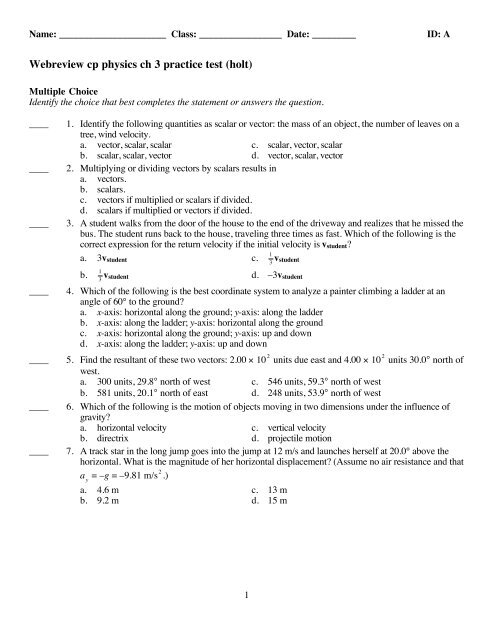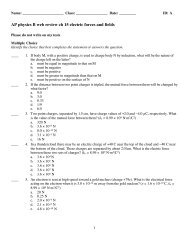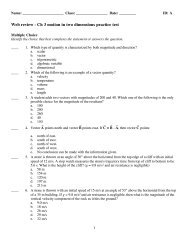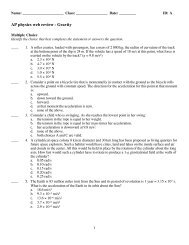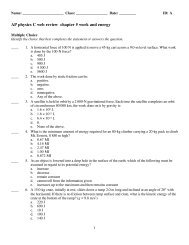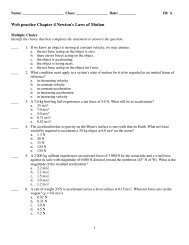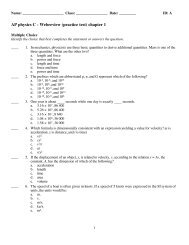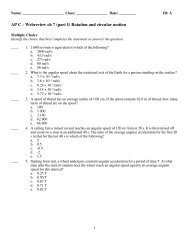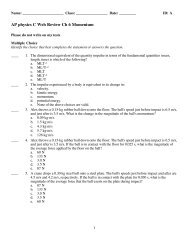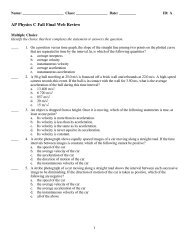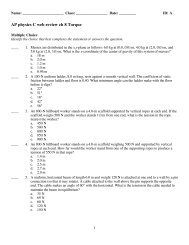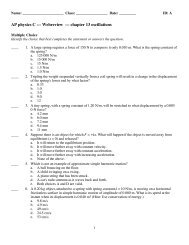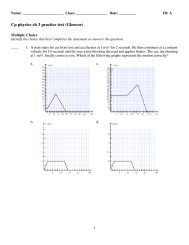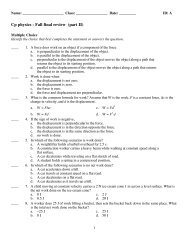Webreview cp physics ch 3 practice test (holt)
Webreview cp physics ch 3 practice test (holt) - Planet Holloway
Webreview cp physics ch 3 practice test (holt) - Planet Holloway
Create successful ePaper yourself
Turn your PDF publications into a flip-book with our unique Google optimized e-Paper software.
Name: ______________________ Class: _________________ Date: _________<br />
ID: A<br />
<strong>Webreview</strong> <strong>cp</strong> <strong>physics</strong> <strong>ch</strong> 3 <strong>practice</strong> <strong>test</strong> (<strong>holt</strong>)<br />
Multiple Choice<br />
Identify the <strong>ch</strong>oice that best completes the statement or answers the question.<br />
____<br />
____<br />
____<br />
____<br />
____<br />
____<br />
____<br />
1. Identify the following quantities as scalar or vector: the mass of an object, the number of leaves on a<br />
tree, wind velocity.<br />
a. vector, scalar, scalar c. scalar, vector, scalar<br />
b. scalar, scalar, vector d. vector, scalar, vector<br />
2. Multiplying or dividing vectors by scalars results in<br />
a. vectors.<br />
b. scalars.<br />
c. vectors if multiplied or scalars if divided.<br />
d. scalars if multiplied or vectors if divided.<br />
3. A student walks from the door of the house to the end of the driveway and realizes that he missed the<br />
bus. The student runs back to the house, traveling three times as fast. Whi<strong>ch</strong> of the following is the<br />
correct expression for the return velocity if the initial velocity is vstudent?<br />
a. 3vstudent c.<br />
1<br />
3 v student<br />
1<br />
b. 3 student d. –3vstudent<br />
4. Whi<strong>ch</strong> of the following is the best coordinate system to analyze a painter climbing a ladder at an<br />
angle of 60° to the ground?<br />
a. x-axis: horizontal along the ground; y-axis: along the ladder<br />
b. x-axis: along the ladder; y-axis: horizontal along the ground<br />
c. x-axis: horizontal along the ground; y-axis: up and down<br />
d. x-axis: along the ladder; y-axis: up and down<br />
5. Find the resultant of these two vectors: 2.00 × 10 2 units due east and 4.00 × 10 2 units 30.0° north of<br />
west.<br />
a. 300 units, 29.8° north of west c. 546 units, 59.3° north of west<br />
b. 581 units, 20.1° north of east d. 248 units, 53.9° north of west<br />
6. Whi<strong>ch</strong> of the following is the motion of objects moving in two dimensions under the influence of<br />
gravity?<br />
a. horizontal velocity c. vertical velocity<br />
b. directrix d. projectile motion<br />
7. A track star in the long jump goes into the jump at 12 m/s and laun<strong>ch</strong>es herself at 20.0° above the<br />
horizontal. What is the magnitude of her horizontal displacement? (Assume no air resistance and that<br />
a y<br />
= –g = –9.81 m/s 2 .)<br />
a. 4.6 m c. 13 m<br />
b. 9.2 m d. 15 m<br />
1
Name: ______________________<br />
ID: A<br />
Short Answer<br />
Problem<br />
The figure above shows the path of a ball tossed from a building. Air resistance is ignored.<br />
8. In the figure above, what would happen to the width of the ball’s path if it were laun<strong>ch</strong>ed with a<br />
greater velocity?<br />
9. In the figure above, what would happen to the height of the ball’s path if it were laun<strong>ch</strong>ed with a<br />
greater velocity?<br />
10. In the figure above, what would happen to the height of the ball’s path if it were laun<strong>ch</strong>ed with a<br />
lesser velocity?<br />
11. In the figure above, what would happen to the width of the ball’s path if it were laun<strong>ch</strong>ed with a lesser<br />
velocity?<br />
12. Describe the graph of the horizontal component of velocity versus time for the motion of the ball<br />
shown in the figure above.<br />
13. Describe the graph of the vertical component of velocity versus time for the motion of the ball shown<br />
in the figure above. Identify any constants that would appear in the graph.<br />
14. Briefly explain why the true path of a projectile traveling through Earth’s atmosphere is not a<br />
parabola.<br />
15. A lightning bug flies at a velocity of 0.25 m/s due east toward another lightning bug seen off in the<br />
distance. A light easterly breeze blows on the bug at a velocity of 0.25 m/s. What is the resultant<br />
velocity of the lightning bug?<br />
2
Name: ______________________<br />
ID: A<br />
16. A jogger runs 10.0 blocks due east, 5.0 blocks due south, and another 2.0 blocks due east. Assume<br />
all blocks are of equal size. Use the graphical method to find the magnitude of the jogger’s net<br />
displacement.<br />
17. A cave explorer travels 3.0 m eastward, then 2.5 m northward, and finally 15.0 m westward. Use the<br />
graphical method to find the magnitude of the net displacement.<br />
18. A quarterback takes the ball from the line of scrimmage and runs backward for 1.0 × 10 1 m. He then<br />
runs sideways, parallel to the line of scrimmage, for 15 m. Next, he throws the ball forward 5.0 × 10 1<br />
m, perpendicular to the line of scrimmage. The receiver is tackled immediately. How far is the football<br />
displaced from its original position?<br />
19. A duck waddles 2.5 m east and 6.0 m north. What are the magnitude and direction of the duck’s<br />
displacement with respect to its original position?<br />
20. While following directions on a treasure map, a person walks 45.0 m south, then turns and walks<br />
7.50 m east. Whi<strong>ch</strong> single straight-line displacement could the person have walked to rea<strong>ch</strong> the same<br />
spot?<br />
21. Vector A is 3.2 m in length and points along the positive y-axis. Vector B is 4.6 m in length and<br />
points along a direction 195° counterclockwise from the positive x-axis. What is the magnitude of the<br />
resultant when vectors A and B are added?<br />
22. A cow ambles through a break in the barnyard fence and wanders 24 m at 40.0° north of east, and<br />
then 13 m east. If the cow’s wanderings last 3.0 minutes, what is the cow’s average velocity?<br />
23. An hockey puck travels 2.00 m at 10.0° east of south before rico<strong>ch</strong>eting 2.50 m at 75.0° north of east.<br />
What is the puck’s resultant displacement?<br />
24. A stone is thrown at an angle of 30.0° above the horizontal from the top edge of a cliff with an initial<br />
speed of 12 m/s. A stopwat<strong>ch</strong> measures the stone’s trajectory time from the top of the cliff to the<br />
bottom at 5.60 s. What is the height of the cliff? (Assume no air resistance and that a y<br />
= −g = −9.81<br />
m/s 2 .)<br />
3
ID: A<br />
<strong>Webreview</strong> <strong>cp</strong> <strong>physics</strong> <strong>ch</strong> 3 <strong>practice</strong> <strong>test</strong> (<strong>holt</strong>)<br />
Answer Section<br />
MULTIPLE CHOICE<br />
1. B<br />
2. A<br />
3. D<br />
4. C<br />
5. D<br />
6. D<br />
7. B<br />
SHORT ANSWER<br />
8. The width of the ball’s path would increase.<br />
9. The height of the ball’s path would increase.<br />
10. The height of the ball’s path would decrease.<br />
11. The width of the ball’s path would decrease.<br />
12. The graph of the horizontal component of the velocity versus time is a straight line parallel to the time<br />
axis.<br />
13. The graph of the vertical component of the velocity versus time is a straight line with a negative slope.<br />
The slope of the line is −9.81 m/s 2 , whi<strong>ch</strong> is −g.<br />
14. With air resistance, a projectile slows down as it collides with air particles. Therefore, the true path of<br />
a projectile would not be a parabola.<br />
PROBLEM<br />
15. 0.00 m/s<br />
Given<br />
v 1<br />
= 0.25 m/s east<br />
v 2<br />
= 0.25 m/s west<br />
Solution<br />
v R<br />
= v 1<br />
− v 2<br />
= 0.25 m/s − 0.25 m/s = 0.00 m/s<br />
16. 13.0 blocks<br />
Solution<br />
Students should use graphical te<strong>ch</strong>niques. Their answers can be <strong>ch</strong>ecked using the te<strong>ch</strong>niques<br />
presented in Section 2.<br />
d = (12.0 blocks) 2 + (5.0 blocks) 2 = 13.0 blocks<br />
1
ID: A<br />
17. 12.2 m<br />
Solution<br />
Students should use graphical te<strong>ch</strong>niques. Their answers can be <strong>ch</strong>ecked using the te<strong>ch</strong>niques<br />
presented in Section 2.<br />
d = (12.0 m) 2 + (2.5 m) 2 = 12.2 m<br />
18. 43 m<br />
Given<br />
Δx 1<br />
= −1.0 × 10 1 m<br />
Δy 1<br />
= 15 m<br />
Δx 2<br />
= +5.0 × 10 1 m<br />
Solution<br />
Δx tot<br />
= Δx 1<br />
+ Δx 2<br />
= (−1.0 × 10 1 m) + (5.0 × 10 1 m) = 4.0 × 10 1 m<br />
Δy tot<br />
= Δy 1<br />
= 15 m<br />
d 2 = (Δx tot<br />
) 2 + (Δy tot<br />
) 2<br />
d = (Δx tot<br />
) 2 + (Δy tot<br />
) 2 = (4.0 × 10 1 m) 2 + (1.5 × 10 1 m) 2 = 4.3 × 10 1 m<br />
19. 6.5 m at 67° north of east<br />
Given<br />
d 1<br />
= 2.5 m east<br />
d 2<br />
= 6.0 m north<br />
Solution<br />
Δx = d 1<br />
= 2.5 m<br />
Δy = d 2<br />
= 6.0 m<br />
d 2 = Δx 2 + Δy 2<br />
d = Δx 2 + Δy 2 = (2.5 m) 2 + (6.0 m) 2 = 6.5 m<br />
Ê Δy ˆ Ê<br />
θ = tan −1<br />
−1<br />
6.0 m ˆ<br />
= tan<br />
Ë<br />
Á Δx ¯<br />
˜<br />
Ë<br />
Á 2.5 m ¯<br />
˜ = 67°<br />
d = 6.5 m at 67°north of east<br />
2
ID: A<br />
20. 45.6 m at 80.5° south of east<br />
Given<br />
d 1<br />
= 45.0 m south<br />
d 2<br />
= 7.50 m east<br />
Solution<br />
Δx = d 2<br />
= 7.50 m<br />
Δy = d 1<br />
= 45.0 m<br />
d 2 = Δx 2 + Δy 2<br />
d = Δx 2 + Δy 2 = (7.50 m) 2 + (45.0 m) 2 = 45.6 m<br />
Ê Δy ˆ Ê<br />
θ = tan −1<br />
−1<br />
45.0 m ˆ<br />
= tan<br />
Ë<br />
Á Δx ¯<br />
˜<br />
Ë<br />
Á 7.50 m ¯<br />
˜ = 80.5°<br />
d = 45.6 m at 80.5°south of east<br />
21. 4.9 m<br />
Given<br />
d 1<br />
= 3.2 m along +y-axis<br />
d 2<br />
= 4.6 m at 195° counterclockwise from +x-axis<br />
d 1<br />
= 3.2 m θ 1<br />
= 0.0°<br />
d 2<br />
= 4.6 m θ 2<br />
= 195°<br />
Solution<br />
Δx 1<br />
= 0.0 m<br />
Δy 1<br />
= 3.2 m<br />
Δx 2<br />
= d 2<br />
cosθ 2<br />
= (4.6 m)(cos195°) = − 4.4 m<br />
Δy 2<br />
= d 2<br />
sinθ 2<br />
= (4.6 m)(sin195°) = −1.2 m<br />
Δx tot<br />
= Δx 1<br />
+ Δx 2<br />
= (0 m) + ( − 4.4 m) = − 4.4 m<br />
Δy tot<br />
= Δy 1<br />
+ Δy 2<br />
= (3.2 m) + (−1.2 m) = 2.0 m<br />
d 2 = (Δx tot<br />
) 2 + (Δy tot<br />
) 2<br />
d = (Δx tot<br />
) 2 + (Δy tot<br />
) 2 = (−4.4 m) 2 + (2.0 m) 2 = 4.9 m<br />
3
ID: A<br />
22. 0.19 m/s, 26° north of east<br />
Given<br />
d 1<br />
= 24 m θ 1<br />
= 40.0° north of east<br />
d 2<br />
= 13 m θ 2<br />
= 0° east<br />
Δt = (3.0 min)(60 s/min) = 180 s<br />
Solution<br />
Δx 1<br />
= d 1<br />
cosθ 1<br />
= (24 m)(cos 40.0°) = 18 m<br />
Δy 1<br />
= d 1<br />
sinθ 1<br />
= (24 m)(sin 40.0°) = 15 m<br />
Δx 2<br />
= 13 m<br />
Δy 2<br />
= 0 m<br />
Δx tot<br />
= Δx 1<br />
+ Δx 2<br />
= 18 m + 13 m = 31 m<br />
Δy tot<br />
= Δy 1<br />
+ Δy 2<br />
= 15 m + 0 m = 15 m<br />
d = (Δx tot<br />
) 2 + (Δy tot<br />
) 2 = (31 m) 2 + (15 m) 2 = 34 m<br />
θ = tan Δy Ê<br />
−1 tot 15 m ˆ<br />
= tan −1<br />
Δx tot Ë<br />
Á 31 m ¯<br />
˜ = 26°<br />
d = 34 m, 26° north of east<br />
v avg<br />
= d Δt = 34 m<br />
180 s<br />
= 0.19 m/s<br />
vavg = 0.19 m/s, 26° north of east<br />
4
ID: A<br />
23. 1.09 m at 24° north of east<br />
Given<br />
d 1<br />
= 2.00 m<br />
d 2<br />
= 2.50 m<br />
θ 1<br />
= 10.0° east of south<br />
θ 2<br />
= 75.0° north of east<br />
Solution<br />
Δx 1<br />
= d 1<br />
sinθ 1<br />
= (2.00)(sin10.0°) = 0.347 m<br />
Δy 1<br />
= d 1<br />
cosθ 1<br />
= (2.00 m)(cos10.0°) = 1.97 m<br />
Δx 2<br />
= d 2<br />
cosθ 2<br />
= (2.50 m)(cos75.0°) = 0.647 m<br />
Δy 2<br />
= d 2<br />
sinθ 2<br />
= (2.50 m)(sin75.0°) = 2.41 m<br />
Δx tot<br />
= Δx 1<br />
+ Δx 2<br />
= 0.347 m + 0.647 m = 0.994 m<br />
Δy tot<br />
= Δy 1<br />
+ Δy 2<br />
= −1.97 m + 2.41 m = 0.44 m<br />
d = (Δx tot<br />
) 2 + (Δy tot<br />
) 2 = (0.994 m) 2 + (0.44 m) 2 = 1.09 m<br />
Ê 0.44 m ˆ<br />
θ = tan −1<br />
Ë<br />
Á 0.994 m ¯<br />
˜ = 24°<br />
d = 1.09 m at 24° north of east<br />
24. 120 m<br />
Given<br />
v i<br />
= 12 m/s at 30.0° above the horizontal<br />
Δt = 5.60 s<br />
g = 9.81 m/s 2<br />
Solution<br />
v i, y<br />
= v i<br />
sinθ = (12 m/s)(sin30.0°) = 6.0 m/s<br />
Δy = v i, y<br />
Δt + 1 2 a y (Δt) 2 = (6.0 m/s)(5.60 s) + 1 2 (−9.81 m/s 2 )(5.60 s) 2<br />
Δy = 34 m – 154 m = − 120 m<br />
h = 120 m<br />
5


